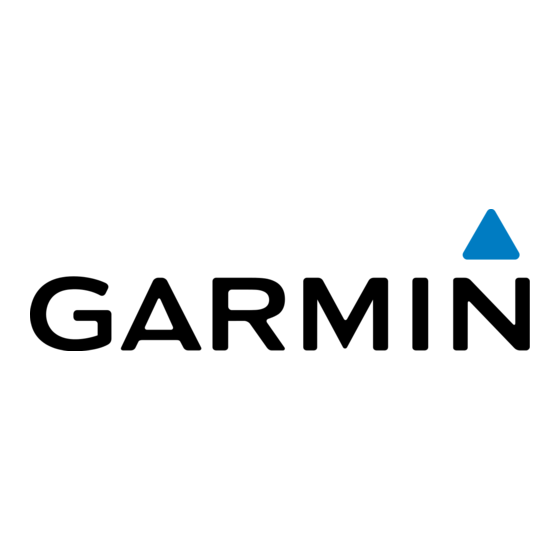Garmin GPSMAP 8000 Series Руководство пользователя - Страница 30
Просмотреть онлайн или скачать pdf Руководство пользователя для Морская система GPS Garmin GPSMAP 8000 Series. Garmin GPSMAP 8000 Series 43 страницы. Installation instructions
Также для Garmin GPSMAP 8000 Series: Руководство пользователя (36 страниц), Краткое руководство по эксплуатации (4 страниц), Руководство по эксплуатации (15 страниц), Руководство по установке (14 страниц)

Synchronizing the Fuel Data with the Actual Vessel
Fuel
You can synchronize the fuel levels in the chartplotter with the
actual fuel in the vessel when you add fuel to your vessel.
1
Select A/V, Gauges, Controls > Engines > Menu.
2
Select an option:
• After you have filled up all the fuel tanks on the vessel,
select Fill Up All Tanks. The fuel level is reset to
maximum capacity.
• After you have added less than a full tank of fuel, select
Add Fuel to Boat, and enter the amount added.
• To specify the total fuel in the vessel tanks, select Set
Total Fuel Onboard, and enter the total amount of fuel in
the tanks.
Viewing the Wind Gauges
Before you can view wind information, you must have a wind
sensor connected to the chartplotter.
Select A/V, Gauges, Controls > Wind.
Configuring the Sailing Wind Gauge
You can configure the sailing wind gauge to show true or
apparent wind speed and angle.
1
From the wind gauge, select Menu > Sailing Wind Gauge.
2
Select an option:
• To show true or apparent wind angle, select Needle, and
select an option.
• To show true or apparent wind speed, select Wind Speed,
and select an option.
Configuring the Speed Source
You can specify whether the vessel speed data displayed on the
gauge and used for wind calculations is based on water speed
or GPS speed.
1
From the wind gauge, select Menu > Compass Gauge >
Speed Display.
2
Select an option:
• To calculate the vessel speed based on data from the
water-speed sensor, select Water Speed.
• To calculate the vessel speed based on GPS data, select
GPS Speed.
Configuring the Heading Source of the Wind Gauge
You can specify the source of the heading displayed on the wind
gauge. Magnetic heading is the heading data received from a
heading sensor, and GPS heading is calculated by your
chartplotter GPS (course over ground).
1
From the wind gauge, select Menu > Compass Gauge >
Heading Source.
2
Select GPS Hdg. or Magnetic.
NOTE: When moving at low speeds or when stationary, the
magnetic compass source is more accurate than the GPS
source.
Customizing the Close-Hauled Wind Gauge
You can specify the range of the close-hauled wind gauge for
both the upwind scale and the downwind scale.
1
From the wind gauge, select Menu > Compass Gauge >
Gauge Type > Close Hauled Gauge.
2
Select an option:
• To set the maximum and minimum values that appear
when the upwind close-hauled wind gauge appears, select
Change Upwind Scale, and set the angles.
• To set the maximum and minimum values that appear
when the downwind close-hauled wind gauge appears,
select Change Downwind Scale, and set the angles.
Tide, Current, and Celestial Information
• To view true or apparent wind, select Wind, and select an
option.
Viewing Trip Gauges
Trip gauges show information for odometer, speed, time, and
fuel for your present trip.
Select Info > Trip & Graphs > Trip.
Resetting Trip Gauges
1
Select Info > Trip & Graphs > Trip.
2
Select an option:
• To set all the readings for the present trip to zero, select
Reset Trip.
• To set the maximum speed reading to zero, select Reset
Maximum Speed.
• To set the odometer reading to zero, select Reset
Odometer.
• To set all the readings to zero, select Reset All.
Viewing Graphs
Before you can view graphs of various environmental changes,
such as temperature, depth, and wind, you must have an
appropriate transducer or sensor connected to the network.
Select Info > Trip & Graphs > Graphs.
Setting the Graph Range and Time Scales
You can indicate the amount of time and the range of depth that
appear in the depth and water temperature graphs.
1
From a graph, select Graph Setup.
2
Select an option:
• To set a time-elapsed scale, select Duration. The default
setting is 10 minutes. Increasing the time-elapsed scale
allows you to view variations over a longer period of time.
Decreasing the time-elapsed scale allows you to view
more detail over a shorter period of time.
• To set the graph scale, select Scale. Increasing the scale
allows you to view more variation in readings. Decreasing
the scale allows you to view more detail in the variation.
Tide, Current, and Celestial
Information
Tide Station Information
You can view information about a tide station for a specific date
and time, including the tide height, and when the next high and
low tides will occur. By default, the chartplotter shows tide
information for the most recently viewed tide station and for the
present date and time.
Select Info > Tides & Currents > Tides.
Current Station Information
NOTE: Current station information is available with certain
detailed maps.
You can view information about a current station for a specific
date and time, including the current speed and level of the
current. By default, the chartplotter shows current information for
the most recently viewed current station and for the present date
and time.
Select Info > Tides & Currents > Currents.
Celestial Information
You can view information about sunrise, sunset, moonrise,
moonset, moon phase, and the approximate sky view location of
the sun and moon. The center of the screen represents the sky
29
